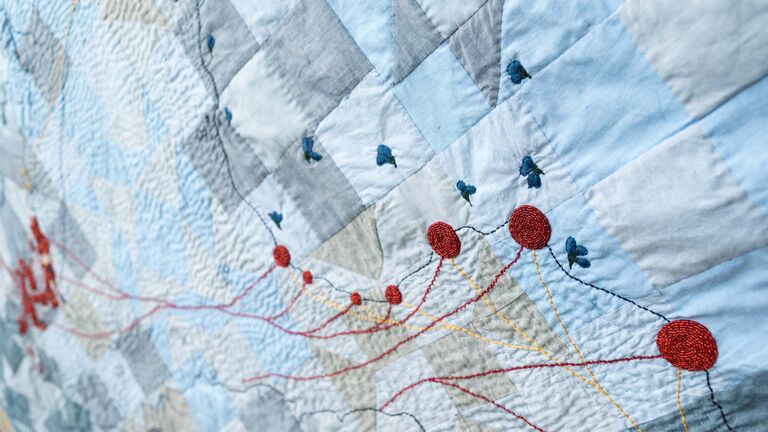
© 2017 School of the Art Institute of Chicago; All Rights Reserved Artwork: Maria Burundarena
Undergraduate Overview
Fiber & Material Studies Undergraduate Overview
The undergraduate Fiber and Material Studies program is the largest in the world and offers a progressive curriculum taught by distinguished and innovative faculty who are leading working artists and scholars in the field. At the School of the Art Institute of Chicago, we teach Fiber and Material Studies in a contemporary fine arts context, emphasizing materiality, experimentation and innovation.
Bachelor of Fine Arts (BFA) students considering a concentration in Fiber and Material Studies, we encourage can enroll in beginning-level classes such as Introduction to Fiber and Material Studies, Drawn to Print, Woven Structure Basics, Papermaking I, To Dye For, and Stitch I. From there, Fiber and Material Studies faculty will help you determine the sequence and selection of upper-level courses best suited to your practice and interests. Those classes include Os + 1s Jacquard Weaving, Print Into Sculpture: 3D Screens, The Unpainted Picture, Time, Material, and the Everyday, Micro/Macro: Artist Research, and advanced weaving, print, dye, and papermaking classes.
We encourage you to seek connections and crossovers between Fiber and Material Studies and other studio and design areas at the school. Our curriculum practices a broad range of concerns incorporating and informed by several key areas:
- Weaving
- Printing and Dyeing
- Construction techniques
- Papermaking
- Sculpture/Soft Sculpture, dimensional forms and Installation
- Stitch
- Painting and collage
- Performance
- Digital technologies
You and your peers will develop a wide range of 2D and 3D work through concerns of hands-on making, concept and content articulated on the surface, in the structure, and through mixed media (crossover disciplines).
BFA in Studio with Thesis Option (Liberal Arts or Visual Critical Studies)
BFA students may complete a nine-credit, research-based academic thesis as part of their studies within the 126 credits for the BFA in Studio degree. BFA with Thesis course sequences are offered over 3 semesters through the departments of Liberal Arts or Visual and Critical Studies (VCS). Students who are interested in one of the thesis options should follow the steps outlined below in the beginning of the junior year.
Requirements for the BFA: Studio Art with Liberal Arts Thesis
Step One: Students are required to meet with the chair of the Liberal Arts department in the beginning of their junior year.
Step Two: With the department chair's approval, the student enrolls in the following courses beginning in the spring term of their junior year:
- SOCSCI or HUMANITY 3900 Academic Research and Writing (3 credits)
- LIBARTS 4800 Undergraduate Thesis: Research/Writing I (3 credits)
- CAPSTONE 4900 Liberal Arts Undergraduate Thesis: Research/Writing II (3 credits)
Step Three: The completed thesis must be approved by both the Thesis II instructor and the Chair of Liberal Arts. Students must make a formal presentation and participate in the Undergraduate Thesis Symposium in their senior year.
Requirements for the BFA: Studio Art with Visual and Critical Studies (VCS) Thesis
Step One: Students are required to meet with the Visual and Critical Studies Undergraduate Coordinator in or by the beginning of their junior year.
Step Two: With the VCS Coordinator's approval, the student enrolls in the first of the three-course sequence beginning in the spring term of their junior year:
- VCS 3010 Tutorial in Visual & Critical Studies (3 credits)
- VCS 4800 Undergraduate Thesis Seminar: Research & Writing I (3 credits)
- CAPSTONE 4900 VCS Undergraduate Thesis Seminar: Research & Writing II (3 credits)
Step Three: Completion of thesis must be approved by both the Thesis II instructor and the VCS Undergraduate Coordinator. Students must make a formal presentation and participate in the Undergraduate VCS Thesis Symposium in the senior year.
Admissions Requirements & Curriculum Overview
-
To apply to the School of the Art Institute of Chicago (SAIC), you will need to fill out an application and submit your transcripts, artist's statement, and letters of recommendation. And most importantly, we require a portfolio of your best and most recent work—work that will give us a sense of you, your interests, and your willingness to explore, experiment, and think beyond technical art, design, and writing skills.
In order to apply, please submit the following items:
- Online application
- Artist’s Statement
- Transcripts
- Letter of Recommendation
- Test Scores
- Portfolio
Bachelor of Fine Arts in Studio Portfolio:
Submit 10–15 pieces of your best and most recent work. We will review your portfolio and application materials for merit scholarship once you have been admitted to SAIC.
When compiling a portfolio, you may concentrate your work in a single discipline or show work in a breadth of media. The portfolio may include drawings, prints, photographs, paintings, film, video, audio recordings, sculpture, ceramics, fashion designs, graphic design, furniture, objects, architectural designs, websites, video games, sketchbooks, scripts, storyboards, screenplays, zines, or any combination of the above.
Learn more about applying to SAIC's Bachelor of Fine Arts in Studio, or view our portfolio preparation guide for more information.
-
BFA students must complete at least 6 credit hours in a class designated as "off campus study." These credits can also fulfill any of the requirements listed above and be from any of the divisions (Art History, Studio, Liberal Arts, or General Electives).
BFA With Distinction—SAIC Scholars Program: The SAIC Scholars program is a learning community of BFA students pursuing rigorous study in both their academic coursework and their studio pathways. There are two opportunities for interested students to apply to the SAIC Scholars Program: at the time of admission to the school, and after they have completed 30 credits of study at SAIC. Students pursuing the latter option are required to formally submit an application to the Undergraduate Division. Once admitted to the SAIC Scholars Program, students are required to successfully complete a minimum of six designated scholars courses. Students who complete the program will graduate with distinction.
Course Listing
Take the Next Step
Visit the undergraduate admissions website or contact the undergraduate admissions office at 800.232.7242 or ugadmiss@saic.edu.
